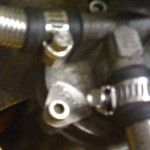01 OctHaving Trouble With SU Carbs Overflowing?
 Having recently had (and fixed) this problem, and done a lot of research, I feel I should place everything I’ve discovered in one post to help anyone else with this issue.
Having recently had (and fixed) this problem, and done a lot of research, I feel I should place everything I’ve discovered in one post to help anyone else with this issue.
1) First and foremost, open up the float lids and check the clearance between the plastic float and the needle. Turned upside down, with the float not yet pushing the needle down but touching it, you should be able to find a clearance between the float and lid of around 1/8″ to 3/16″. Use those sizes of drill bit and roll them under (making sure they’re parallel with the float lid) to find out.
2) Take out the float. You need to pinch the serrated end of the hinge pin with a pair of pliers, and tug – but be careful, as the float will fall out quickly, you don’t want to break it. Put the float in a tub of water or petrol and push it down. Does it float properly? If not, you need a new one. It should spring up pretty quickly, and also shake it afterwards – if you can hear anything inside that’s a dead giveaway that it’s kaput.
3) Now that the float is out, you can take out the needle and seat with your socket set (a spanner won’t fit). Examine underneath, on mine I had lots of crud stuck there blocking the hole. Also remove the needle from the seat, check it all over for wear. A worn needle doesn’t work properly, if its worn, replace it or try Grose Jets. Their advantage is that by using a ball bearing instead of a needle, there’s a lot more surface area to resist wear in one specific place.
4) If the above still don’t fix your problem, you may have flooding due to a buildup of vapour. I didn’t have this problem, but it was something I suspected since my float lid didn’t have any venting holes or overflow pipes. Some do, some don’t. The ones that have pipes will direct any overflowing fuel to a safer location than where it would normally spill onto. Okay it’s a bit lame accepting it as inevitable that your carbs might overflow, but it’s better to be safe than sorry. If I had the choice, I’d take carbs with an overflow pipe, and better yet a catch tank at the end of the pipes to catch any fuel.
5) The pressure entering the carbs might be too high, this is more likely with a non-original-type fuel pump. A fuel regulator to regulate the pressure to 2-2.5 psi is handy.








